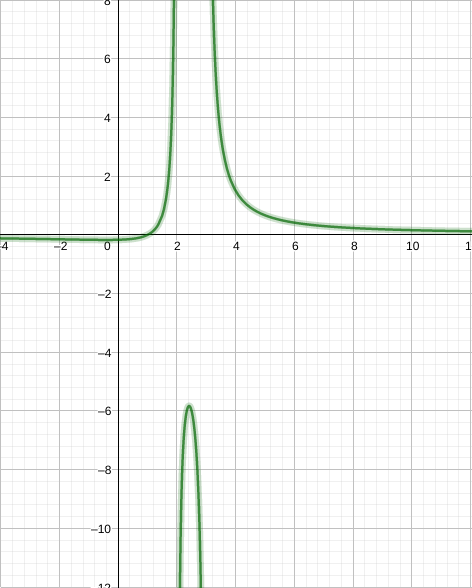aula anterior | próxima aula
Digitado por $\color{black} \text{Diefesson de Sousa Silva - 471942}$
Limites(continuação)
Nas últimas aulas, verificamos a comportamento dos limites pela $\color{red} \text{esquerda}$ e pela $\color{red}\text{direita}$ de uma função. Relembrando:
Limite lateral pela direita de $f(x)$:
$\lim_{x \rightarrow a^+}f(x) = L_1$
Limite lateral pela esquerda $f(x)$:
$\lim_{x \rightarrow a^-}f(x) = L_2$
Definimos que, quando $L_1$ e $L_2$, a função $f(x)$ terá limite em $x = a$ se, e somente se:
$\lim_{x \rightarrow a^+}f(x) = \lim_{x \rightarrow a^-}f(x)$
Ou seja:
$\lim_{x \rightarrow a}f(x) = L_1 = L_2$
Limites infinitos
Vamos observar o que acontece com funções reais próximas de um ponto de indeterminação.
EX
$f(x) = \frac{1}{x^2}$
Veja que próximo de $x = 0$, bilateralmente, há a seguinte condição:
1.
$\lim_{x \rightarrow 0^+}f(x) = +\infty (\text{infinito})$
Veja que $f(x) = \dfrac{1}{x^2}$ tende a um valor muito grande e positivo quando $x$ está próximo de $x = 0$ pela direita.
2.
$\lim_{x \rightarrow 0^-}f(x) = +\infty(\text{infinito})$
Por outro lado, ao analisar o comportamento pela esquerda($0^-$), elevemos um número negativo ao quadrado, que o torna positivo, Tem-se p mesmo fenômeno quando $x > 0$, logo:
$\lim_{x \rightarrow 0^-}f(x) = \lim_{x \rightarrow 0^+}f(x) = +\infty$
DEFINIÇÃO:
Quando o limite lateral de uma função($x \rightarrow a^- ou x \rightarrow a^+$) é infinito, dizemos que a reta $x = a$ é uma $\color{red}\text{assíntota vertical}$ de $f(x)$. Por sua vez, pelo menos uma das seguintes condições deve ser satisfeita:
$\lim_{x \rightarrow a}f(x) = +\infty \text{ ou } -\infty$
$\lim_{x \rightarrow a^-}f(x) = +\infty \text{ ou } -\infty$
$\lim_{x \rightarrow a^+}f(x) = +\infty \text{ ou } -\infty$
EX:
Verifique a função possuí assíntotas verticais:
$f(x) = \frac{x - 1}{x^2 - 5x + 6}$
$
x^2 - 5x + 6 \Rightarrow \Delta
\Delta = b^2 - 4ac \Leftrightarrow
\Delta = (-5)^2 - 4\cdot1\cdot6 \Leftrightarrow
\Delta = 25 - 24 \Leftrightarrow
\Delta = 1
$
$ x = \frac{-b \pm \sqrt\Delta}{2a} $
$ x_1 = \dfrac{5 + 1}{2} = 3 $
$ x_2 = \dfrac{5 - 1}{2} = 2 $
$ \lim_{x \rightarrow 2^-} f(x) = + \infty \lim_{x \rightarrow 2^+} f(x) = - \infty $
$ \lim_{x \rightarrow 3^+} f(x) = - \infty \lim_{x \rightarrow 3^-} f(x) = + \infty $

ATIVIDADE:
Encontrar a(s) assíntotas da função:
$f(x) = \frac{2x}{x-3}$
E determinar seus limites laterais.

Assíntota em $x = 3$
$\lim_{x \rightarrow 3^-} = -\infty \lim_{x \rightarrow 3^+} = +\infty$
| $\bold x$ | $\bold {f(x)}$ |
|---|---|
| $2$ | $-4$ |
| $2,5$ | $-10$ |
| $2,8$ | $-28$ |
| $2,9$ | $-58$ |
| $2,99$ | $-598$ |
| $2,999$ | $-5998$ |
| $\bold x$ | $\bold{f(x)}$ |
|---|---|
| $4$ | $8$ |
| $3,5$ | $14$ |
| $3,2$ | $32$ |
| $3,1$ | $62$ |
| $3,01$ | $602$ |
| $3,001$ | $6002$ |